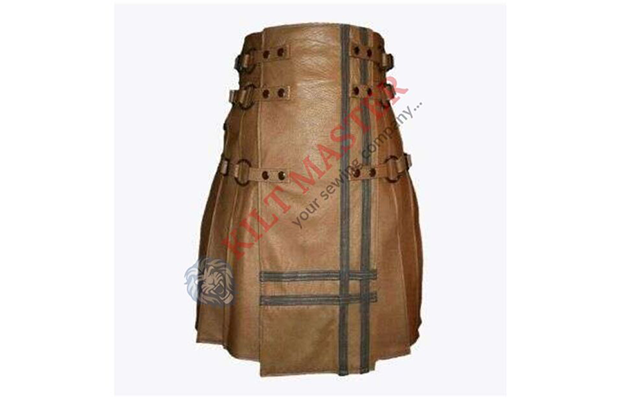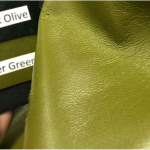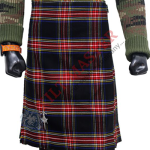Leather kilts Traditional Kilt Styles are a modern twist on a traditional garment, combining the rich history of the kilt with the boldness and durability of leather. This fusion of old and new offers a distinctive look that balances heritage and contemporary style. In this blog, we’ll explore the evolution of leather kilts, their various styles, and how they stand out from other types of kilts such as utility, tartan, camouflage, and denim kilts.
The Evolution of Leather Kilts
Leather kilts have gained popularity in recent years, offering a fresh take on the classic Scottish kilt. Traditionally, kilts are made from woolen tartan fabric reflecting Scotland’s cultural heritage. Leather kilts, however, introduce a rugged and edgy element that modern fashion enthusiasts find appealing.
Historical Roots
The kilt originating in Scotland was historically crafted from woolen tartan fabric. Which sign clan allegiance and social status. Leather on the other hand, has been used throughout history for its durability and versatility but not commonly for kilts. The introduction of leather into kilt design represents a significant departure from tradition while still honoring the garment’s iconic silhouette.
Modern Adaptations
Contemporary leather kilts incorporate elements of both traditional and modern fashion. They often feature classic kilt elements such as pleats and buckles but are craft from leather to create a striking contrast. This blend of old and new provides a unique aesthetic that appeals to those who appreciate both heritage and innovation.
Utility Kilts: Practicality Meets Style
Utility kilts are designed for functionality and practicality while maintaining the traditional kilt silhouette. They are an excellent choice for those who seek a balance between style and utility.
Features and Functionality
Utility kilts are made from durable materials like cotton or polyester and often include features such as pockets, tool loops and adjustable waistbands. These elements make them ideal for various activities, from work to outdoor adventures. The practicality of utility kilts does not come at the expense of style; they are available in a range of colors and designs, allowing for personal expression.
Comparing to Leather Kilts
While leather kilts focus on a rugged, edgy look, utility kilts emphasize functionality and practicality. Both styles can be worn in casual settings, but utility kilts are particularly suited for active wearers who need additional features and durability.
Tartan Kilts: Embracing Tradition
Tartan kilts are the quintessential representation of Scottish heritage, known for their distinctive plaid patterns and historical significance.
The Significance of Tartan
Tartan patterns are deeply ingrain in Scottish culture, with each design representing a different clan or region. The fabric used in tartan kilts is traditionally woolen, which provides warmth and durability. Tartan kilts are often during formal events, ceremonies, and cultural celebrations.
Tartan vs. Leather Kilts
While tartan kilts celebrate Scottish tradition with their distinctive plaid patterns and historical connections, leather kilts offer a more contemporary and edgy look. Both styles have their own unique appeal and can be chosen base on the occasion and personal style preferences.
Camouflage Kilts
Camouflage kilts introduce a military-inspired aesthetic to the traditional kilt, offering a unique twist on this classic garment.
Design and Purpose
Camouflage kilts feature patterns inspired by military camouflage. Making them a popular choice for outdoor enthusiasts and those who appreciate a rugged, utilitarian style. These kilts are often from durable fabrics such as cotton or polyester and can include practical elements like pockets and reinforce areas.
Camouflage vs. Leather Kilts
While camouflage kilts focus on a military-inspired look with functional design elements, leather kilts emphasize a bold and edgy appearance. Both styles cater to different tastes and purposes, allowing individuals to express their personal style in unique ways.
Denim Kilts: A Contemporary Twist
Denim kilts offer a modern casual take on the traditional kilt. Using denim fabric to create a versatile and fashionable garment.
Denim as a Fabric Choice
Denim kilts are craft from the same material use in jeans. Providing a casual and relaxed look. They are often design with features such as pockets and belt loops. Combining the practicality of utility kilts with the stylishness of denim.
Denim vs. Leather Kilts
Denim kilts offer a more casual, everyday look compared to the bold and edgy appeal of leather kilts. While both styles bring a modern twist to the traditional kilt, denim kilts are ideal for casual settings and everyday wear.
Conclusion
Leather kilts Traditional Kilt Styles represent a unique convergence of tradition and modernity. Offering a striking contrast to other types of kilts such as utility, tartan, camouflage, and denim. Each style of kilt brings its own distinct characteristics and appeal. Allowing individuals to choose a garment that best reflects their personal style and needs. Whether embracing the classic tartan, the rugged camouflage, the practical utility . The contemporary denim, the kilt remains a versatile and enduring symbol of cultural heritage.



